The Sri Lankan handloom industry – By Malsha – eLanka
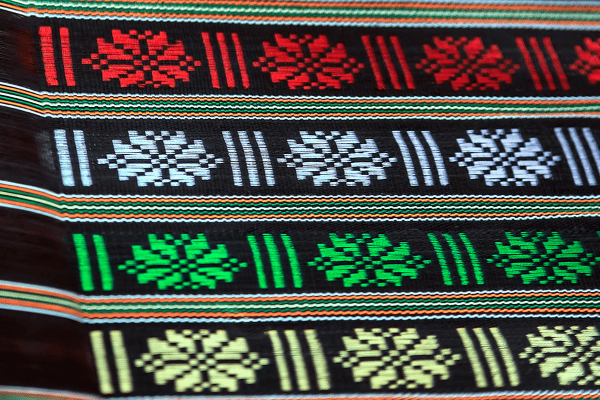
The Sri Lankan handloom industry has a rich history and is known for its traditional handcrafted textiles. Handloom weaving has been a prominent craft in Sri Lanka for centuries, passed down through generations. The industry plays a significant role in the country’s economy, as well as in preserving the cultural heritage and traditional craftsmanship.
Handloom textiles produced in Sri Lanka are renowned for their intricate designs, vibrant colors, and high-quality craftsmanship. The industry primarily focuses on producing fabrics such as cotton, silk, and wool, which are transformed into a variety of products, including garments, home textiles, and accessories.
The handloom industry in Sri Lanka employs a large number of skilled artisans, particularly women in rural areas. It provides them with opportunities for income generation and economic empowerment. Many of these artisans work in small-scale home-based operations or in weaving cooperatives.
The Sri Lankan government has recognized the importance of the handloom industry and has taken several initiatives to support its growth. These include providing training and skill development programs for weavers, facilitating access to credit and financial assistance, and promoting handloom products in domestic and international markets.
In recent years, there has been a renewed interest in handloom textiles, both domestically and globally, due to their unique craftsmanship, sustainable production methods, and cultural significance. Sri Lankan handloom products have gained popularity for their authenticity, eco-friendliness, and ethical production practices.
The handloom industry has also benefited from collaborations with fashion designers, both local and international, who incorporate handloom fabrics into their collections, giving traditional Sri Lankan textiles a contemporary appeal.
Overall, the Sri Lankan handloom industry continues to thrive, blending tradition with innovation, and contributing to the socio-economic development of the country while preserving its cultural heritage.
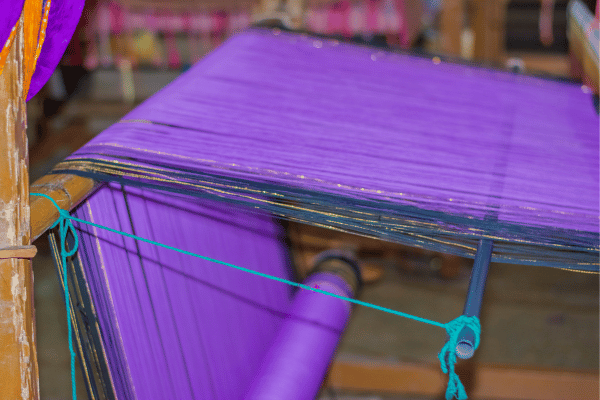
The history of the handloom industry in Sri Lanka dates back thousands of years. Handloom weaving has been an integral part of Sri Lankan culture and heritage, with a rich tradition that has been passed down through generations.
The origins of handloom weaving in Sri Lanka can be traced back to the ancient times of the country. The weaving techniques and designs were influenced by various factors, including indigenous practices, cultural interactions, and trade relationships with other nations.
Historically, Sri Lanka was known for its high-quality handloom textiles, which were sought after in the international market. The island’s strategic location along ancient maritime trade routes contributed to the exchange of ideas, techniques, and materials with other civilizations.
During the colonial period, the handloom industry faced challenges due to the introduction of machine-made textiles from Europe. However, the local artisans continued to preserve and develop their craft, adapting to changing demands and market trends.
After gaining independence from colonial rule, the Sri Lankan government recognized the importance of reviving and supporting the handloom industry. Efforts were made to provide training, infrastructure, and marketing support to handloom weavers, encouraging their creativity and entrepreneurship.
Over the years, the industry has undergone significant transformations. Traditional handlooms have been combined with modern technology, allowing for greater efficiency and quality control. Design innovations and collaborations with fashion designers have brought Sri Lankan handloom textiles to the forefront of the global fashion scene.
The handloom industry has also played a crucial role in the social and economic development of Sri Lanka. It has provided employment opportunities, especially for women in rural areas, empowering them economically and contributing to poverty alleviation.
Today, the handloom industry in Sri Lanka continues to thrive, preserving traditional techniques while embracing innovation. Handloom textiles are not only valued for their exquisite craftsmanship but also for their sustainability and ethical production practices, making them highly sought after in domestic and international markets.
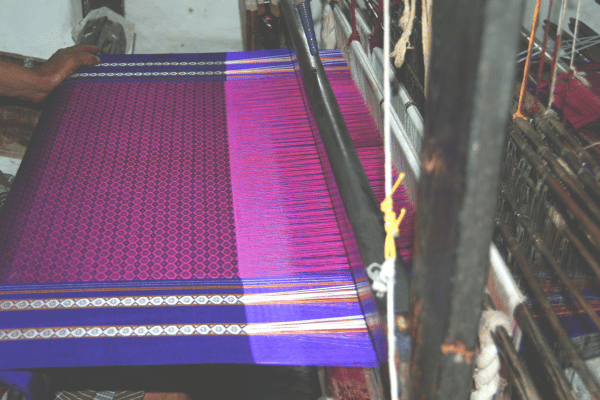
In Sri Lanka, the handloom industry produces various types of handloom textiles, each with its own unique characteristics. Here are some of the commonly produced types of handlooms in Sri Lanka:
- Sarongs: Sarongs are one of the most recognizable and widely worn traditional garments in Sri Lanka. They are rectangular pieces of fabric, typically made from cotton, silk, or a blend of both. Sarongs often feature vibrant colors and intricate designs, representing the diverse cultural heritage of the country.
- Sarees: Sarees are traditional garments worn by women in Sri Lanka and many other South Asian countries. Handloom sarees are meticulously woven with fine threads, often featuring elaborate patterns and motifs. They come in various materials such as silk, cotton, and mixed blends.
- Shawls: Handloom shawls are woven using warm and luxurious materials such as wool or silk. They are known for their softness, intricate patterns, and vibrant colors. Shawls are versatile accessories that can be draped over the shoulders or worn as head coverings.
- Batik: Batik is a unique textile art form that involves the application of wax and dyes to create intricate designs on fabric. Sri Lankan handloom batik textiles are highly prized for their exquisite patterns and vibrant colors. The process of batik involves a combination of hand painting and wax-resist dyeing.
- Handloom Fabrics: Apart from specific garments, handloom weavers in Sri Lanka produce a wide range of fabrics. These include cotton, silk, and wool fabrics that can be used for various purposes such as clothing, home textiles, upholstery, and accessories. Handloom fabrics come in different textures, weights, and designs to suit different preferences and applications.
- Home Textiles: Handloom textiles are not limited to clothing. Sri Lankan artisans also produce a variety of handloom home textiles, including tablecloths, bedspreads, pillow covers, curtains, and rugs. These textiles often feature traditional designs and add a touch of elegance and cultural heritage to home decor.
These are just a few examples of the types of handloom textiles produced in Sri Lanka. The industry is known for its diversity and creativity, continuously evolving to meet the changing demands of the market while preserving the country’s rich textile heritage.
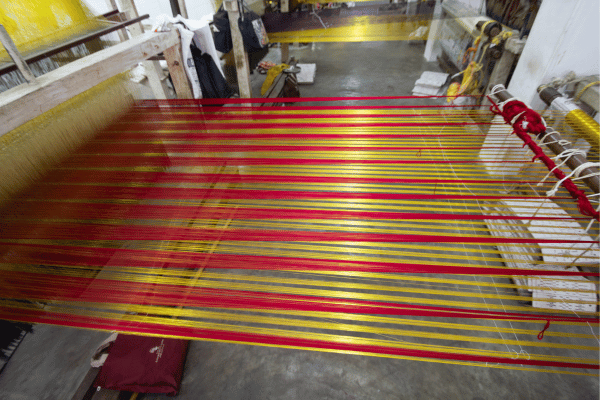
Sri Lanka is renowned for its diverse range of handloom products. These products showcase the exquisite craftsmanship and artistic traditions of the country. Here are some of the prominent Sri Lankan handloom products:
- Sarongs: Sarongs, also known as “sarama” or “redda,” are vibrant, rectangular pieces of fabric that are worn as traditional garments by both men and women. Sri Lankan sarongs are known for their intricate designs and vivid colors, reflecting the cultural heritage of the island.
- Sarees: Sarees are traditional garments primarily worn by women. Sri Lankan handloom sarees are highly prized for their craftsmanship and intricate weaving patterns. They are available in various materials like silk, cotton, and mixed blends, with each region in Sri Lanka having its own distinctive style.
- Shawls: Handloom shawls are woven using warm and luxurious materials such as silk or wool. They are appreciated for their softness, intricate designs, and vibrant colors. Shawls from Sri Lanka often feature traditional motifs and make elegant accessories for both casual and formal wear.
- Batik Products: Batik is a unique textile art form in which wax is applied to fabric to create intricate patterns before dyeing. Sri Lankan batik products include clothing items like dresses, shirts, and scarves, as well as home décor items like tablecloths, wall hangings, and cushion covers.
- Home Textiles: Sri Lankan handloom weavers produce a variety of home textiles, including table runners, placemats, bedspreads, pillow covers, curtains, and rugs. These textiles often feature traditional designs, vibrant colors, and intricate weaving patterns, adding a touch of elegance and cultural richness to home decor.
- Bags and Accessories: Sri Lankan handloom products also include a range of bags and accessories. Handwoven tote bags, backpacks, purses, and pouches made from natural fibers or blended materials are popular choices. Additionally, belts, hats, and hair accessories crafted using handloom techniques are also available.
- Decorative Items: Handloom weavers in Sri Lanka create decorative items such as wall hangings, tapestries, and decorative panels. These pieces often feature traditional motifs, vibrant colors, and intricate weaving patterns, making them unique additions to interior decor.
- Traditional Crafts: Sri Lanka has a rich heritage of traditional crafts, including woven handicrafts like mats, baskets, and hats. These crafts showcase the skill and creativity of local artisans and make for authentic souvenirs or functional items.
These are just a few examples of the wide range of handloom products that Sri Lanka offers. Each product carries a piece of the country’s cultural heritage, craftsmanship, and artistic traditions.
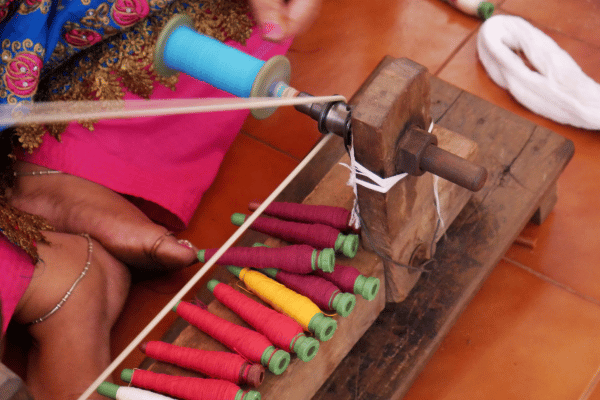
The raw materials used in handloom weaving vary depending on the type of textile being produced and the desired characteristics of the final product. Here are some commonly used raw materials in handloom weaving:
- Cotton: Cotton is one of the most widely used fibers in handloom weaving. It is a natural fiber known for its softness, breathability, and versatility. Cotton yarns of different thicknesses and qualities are used to create a wide range of handloom textiles, from lightweight fabrics to sturdy and durable materials.
- Silk: Silk is a luxurious natural fiber that is highly valued for its smoothness, luster, and draping qualities. Silk yarns are used to produce fine, delicate handloom fabrics such as sarees, shawls, and scarves. Sri Lanka is renowned for its high-quality silk handlooms.
- Wool: Wool is a natural fiber derived from the fleece of sheep or other animals. It is known for its warmth, insulation, and softness. Wool yarns are used to create handloom fabrics like shawls, blankets, and rugs that provide comfort and coziness.
- Jute: Jute is a strong, natural vegetable fiber derived from the jute plant. It is commonly used in handloom weaving for creating coarse, textured fabrics and home décor items like mats, wall hangings, and bags.
- Synthetic Fibers: While handloom weaving traditionally involves natural fibers, there is also a growing use of synthetic fibers such as polyester and nylon. These fibers offer characteristics like strength, durability, and wrinkle resistance. Blends of synthetic fibers with natural fibers are also used to combine the best properties of both materials.
- Natural Dyes: In addition to raw materials, natural dyes derived from plants, flowers, roots, and bark are often used to color handloom textiles. Natural dyes provide a wide range of colors and shades and are valued for their eco-friendly and sustainable characteristics.
It’s important to note that the availability and use of raw materials can vary depending on factors like geographic location, local resources, and market demands. Handloom weavers often source their raw materials from local suppliers, ensuring the quality and authenticity of the fibers used in their textiles.
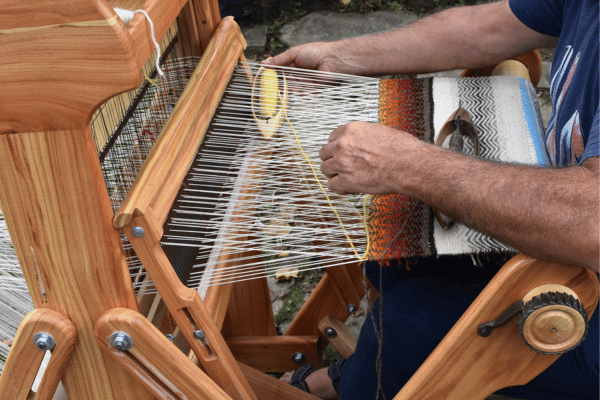
A handloom machine, also known as a manual loom, is a traditional weaving device operated manually by hand. Unlike modern power looms that are operated using electricity or other power sources, handloom machines rely solely on human power.
The basic structure of a handloom machine consists of a frame, heddles, shuttle, and a mechanism for raising and lowering the warp threads. Here’s a brief description of each component:
- Frame: The frame of a handloom machine provides the structural support for the weaving process. It typically consists of two vertical beams, known as the warp beam and cloth beam, which hold the warp and woven fabric respectively. The warp threads are stretched between these two beams.
- Heddles: Heddles are vertical cords or wires attached to frames within the loom. They have small eyelets or loops through which the warp threads pass. The heddles help in raising and lowering specific sets of warp threads to create the shed, which is the space through which the weft thread is inserted.
- Shuttle: The shuttle is a wooden or metal device that holds the weft thread. It is passed through the shed between the raised and lowered warp threads, interlacing with them to create the woven fabric. The shuttle is manually thrown or passed from one side of the loom to the other.
- Shed Mechanism: The shed mechanism is a part of the handloom machine that creates the opening or gap between the raised and lowered warp threads. It allows the weaver to pass the shuttle through the shed smoothly. In a handloom machine, the shed is created manually by manipulating the heddles.
The weaver operates the handloom machine by using foot pedals or levers to raise and lower the heddles, creating the shed. The weft thread is inserted through the shed using the shuttle, and the process is repeated row by row to create the woven fabric.
Handloom machines are often used in traditional handloom weaving industries and are known for producing textiles with unique textures and designs. While they require more time and manual effort compared to power looms, handloom machines offer a distinct artisanal quality and are valued for their craftsmanship.
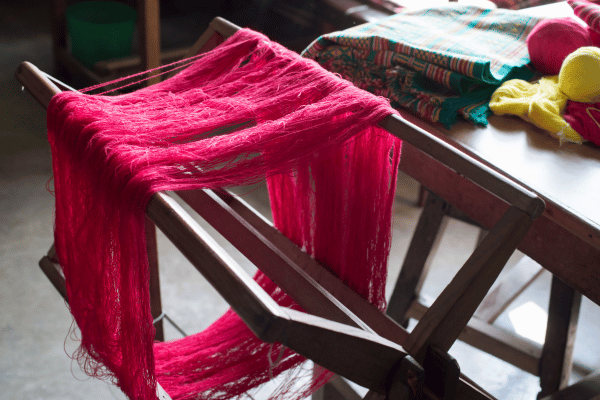
Developing the Sri Lankan handloom industry requires a multi-faceted approach that focuses on various aspects of the industry. Here are some strategies and steps that can contribute to the development of the Sri Lankan handloom industry:
- Skill Development and Training: Providing training programs and skill development initiatives to handloom weavers is crucial. This includes technical training in weaving techniques, design development, product diversification, and quality control. Training programs can be organized by government institutions, industry associations, or collaborations with educational institutions.
- Research and Development: Encouraging research and development activities within the handloom industry can lead to innovation in design, technology, and product development. This can involve exploring new dyeing techniques, experimenting with different fibers and blends, and incorporating modern design elements while preserving traditional craftsmanship.
- Access to Finance and Credit: Ensuring easy access to finance and credit for handloom weavers is essential. Financial institutions can provide specialized loan schemes, microfinance options, or grants to support the procurement of raw materials, machinery upgrades, and working capital requirements.
- Infrastructure and Technology Upgrades: Developing infrastructure to support the handloom industry is crucial. This includes establishing weaving centers, common facilities for dyeing and finishing, and technology parks for research and development. Upgrading technology, such as introducing modern looms or providing necessary equipment and tools, can enhance productivity and efficiency.
- Market Development and Promotion: Effective marketing and promotion of Sri Lankan handloom products both domestically and internationally is crucial for industry growth. This can be achieved through participation in trade fairs, exhibitions, and fashion shows, as well as online platforms to reach a wider audience. Collaborations with fashion designers, retailers, and exporters can also help in expanding market reach.
- Quality Assurance and Certification: Implementing quality assurance measures and obtaining certifications can enhance the reputation and competitiveness of Sri Lankan handloom products. Encouraging weavers to adhere to quality standards, providing guidance on product quality, and obtaining recognized certifications for sustainability and ethical production practices can build trust among consumers.
- Policy Support and Incentives: The Sri Lankan government should provide policy support and incentives to the handloom industry. This includes offering tax incentives, subsidies, and grants for capacity building, research and development, and marketing activities. Creating a favorable policy environment that supports the growth and sustainability of the handloom industry is essential.
- Collaboration and Networking: Encouraging collaboration among handloom weavers, industry associations, designers, and other stakeholders can lead to knowledge sharing, skill enhancement, and collective marketing initiatives. Creating platforms for networking and collaboration, such as weaving cooperatives and craft clusters, can strengthen the industry as a whole.
By implementing these strategies and initiatives, the Sri Lankan handloom industry can be developed and strengthened, ensuring its sustainability, economic growth, and preservation of traditional craftsmanship.







